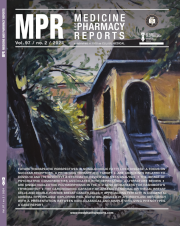Optical properties of zirconia-reinforced lithium silicate veneers obtained with CAD/CAM milling and hot-pressing techniques: a comparative in vitro study
DOI:
https://doi.org/10.15386/mpr-2654Keywords:
translucency, heat-pressing, CAD/CAM, color stability, dental materialsAbstract
Background and aims. Dental veneers have become increasingly required among patients, but little is known about the optical properties of veneers obtained from the same ceramic material through different processing techniques.
Methods. In this study we compared the translucency and the opalescence parameters of zirconia-reinforced lithium silicate (ZLS) veneers restorations fabricated through CAD/CAM milling and hot-pressing techniques on the upper central incisor. Eighty specimens divided into 8 groups (n=10) were sectioned (Celtra Duo) and heat pressed (Celtra Press) to obtain 0.8 mm thickness. The optical parameters were calculated from the color difference against different backgrounds. Analysis of variance, one way ANOVA and post-hoc multiple comparison tests were used to evaluate and compare the optical properties of the same material, with a significance level of p < 0.05.
Results. The processing method had significant effect on optical parameters. Celtra Duo HT proved to be the material with the highest transparency degree. The hot-pressing technique led to higher opacity than CAD/CAM milling technique.
Conclusions. For a bio-mimetic aesthetic prosthetic restoration, the ceramic materials must have the same translucency and opacity as the real tooth. The results of this study revealed that high translucency ZLS obtained through hot pressing technique was the material of choice, as it fulfilled these requirements.
Downloads
Published
How to Cite
Issue
Section
License
The authors are required to transfer the copyright of the published paper to the journal. This is done by agreeing to sign the Copyright Assignment Form. Whenever the case, authors are also required to send permissions to reproduce material (such as illustrations) from the copyright holder.

The papers published in the journal are licensed under a Creative Commons Attribution-NonCommercial-NoDerivatives 4.0 International License.

